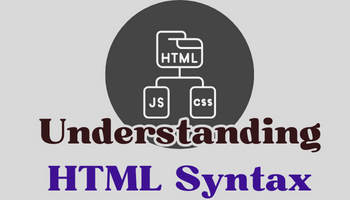Demystifying HTML Syntax
In the digital age, understanding HTML (Hypertext Markup Language) is akin to knowing the alphabet of the internet. HTML serves as the fundamental language for creating web pages, defining their structure and content. Whether you're an aspiring web developer or just curious about how websites work, a deep grasp of HTML syntax is indispensable. In this comprehensive guide, we will delve into the intricacies of HTML syntax and explore how it forms the bedrock of every web page you encounter.
HTML Documents: The Root of Web Pages
At the heart of every web page lies an HTML document. An HTML document is encapsulated within <html> and </html> tags, establishing it as the root element of the page. This structured approach provides a foundation upon which all content and elements within the page are built.
Document Sections: <head> and <body>
HTML documents consist of two primary sections: <head> and <body>.
<head>: The<head>section houses metadata about the document. It includes information such as the page title (<title>), character encoding (<meta charset="UTF-8">), and links to external resources like stylesheets and JavaScript files. While the content in the<head>section is not visible on the web page, it plays a pivotal role in the page's functionality and search engine optimization.<body>: The<body>section contains the visible content of the web page. This is where you place text, images, links, forms, and other elements that users interact with. Everything that users see and engage with on the web page resides within the<body>.
HTML Elements: The Foundation of Content
HTML employs elements or tags to define different parts of a web page. Elements are represented by tags enclosed in angle brackets, such as <tagname>. Most HTML elements consist of an opening tag <tagname> and a corresponding closing tag </tagname>, with content placed between them.
Common HTML Elements
<h1> to <h6>: These tags define headings of varying levels, with<h1>representing the highest level (most significant) and<h6>the lowest. Headings provide structure to your content, making it more accessible and organized.<p>: The paragraph tag is used to create text paragraphs on the web page. It's a fundamental element for presenting textual content.<a>: The anchor tag is employed for hyperlinks. It allows you to link to other web pages or resources. Thehrefattribute within the<a>tag specifies the destination URL.<img>: This self-closing tag embeds images on the page, enhancing its visual appeal and conveying information through visuals.<ul>and<ol>: These tags create unordered and ordered lists, respectively. You can use <li> within these lists to define list items, creating structured content.<div>and<span>: These are versatile containers used for grouping and styling elements.<div>is a block-level container, while<span>is an inline container. They help structure content and apply CSS styles for layout and presentation.
Self-Closing Elements
Some elements are self-closing, meaning they do not require a corresponding closing tag. For example, <br> creates a line break within text, and <hr> draws a horizontal rule to visually separate content.
<p>This is a <br> line break.</p>In this example, the <br> tag is self-closing and does not require a closing tag.
Attributes: Enhancing Element Functionality
HTML elements can have attributes, which provide additional information about the element. Attributes are placed within the opening tag and typically follow a name-value pair format.
Consider an anchor (<a>) element:
<a href="https://www.example.com">Visit Example</a>Here, href is an attribute that specifies the hyperlink's destination, which in this case is "https://www.example.com." Attributes empower elements with additional functionality and customization options.
Nesting Elements: Creating Hierarchies
HTML allows you to nest elements within one another, forming complex structures. Proper nesting is essential for maintaining the page's integrity and ensuring it displays as intended.
<div>
<h1>Welcome to Our Website</h1>
<p>Explore our <a href="products.html">products</a> and discover <strong>amazing deals</strong>.</p>
</div>In this example, the <h1> and <p> elements are nested within a <div> container. This organization keeps the content structured and allows for consistent styling.
Conclusion
HTML syntax serves as the bedrock upon which all web pages are constructed. Understanding the structure of HTML documents, the purpose of elements, the use of attributes, and the practice of nesting elements is pivotal for creating web content. As you delve deeper into web development, you'll realize the power and versatility of HTML, enabling you to craft engaging, interactive, and visually appealing web experiences that captivate and inform users worldwide.

